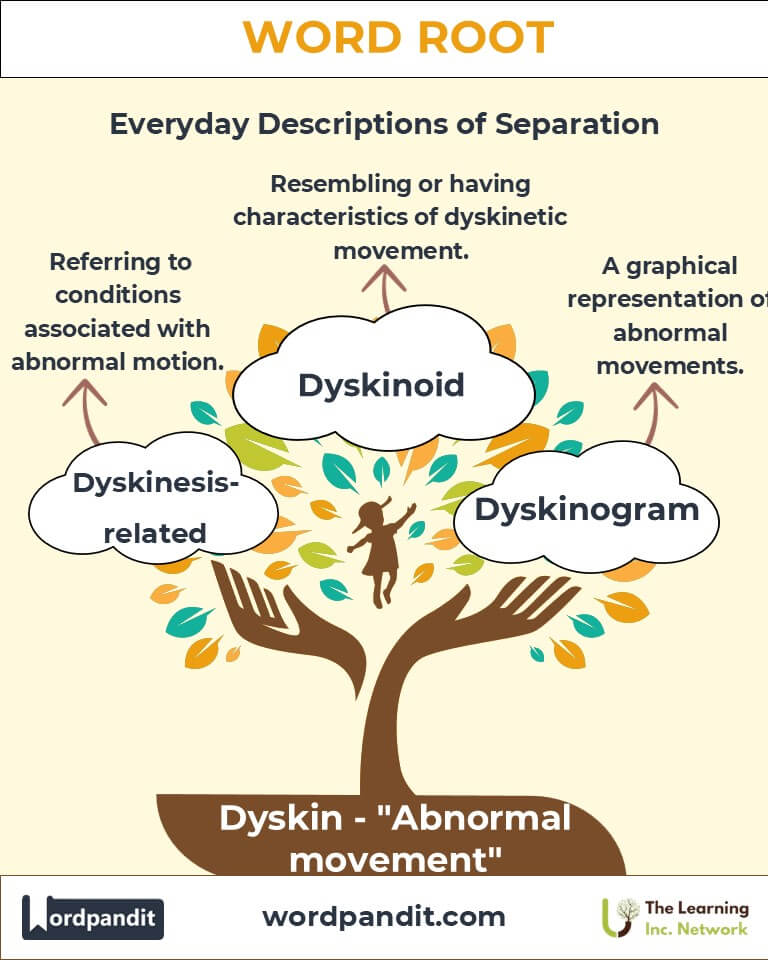Dyskin: The Language of Movement Challenges Across Disciplines
Discover the complexity and significance of the root "dyskin," derived from Greek, meaning "difficult movement." From medical conditions to specialized terminology, explore how this root illustrates the intricacies of motion and its challenges in human physiology and beyond.

Table of Contents
- Introduction: The Essence of Dyskin
- Etymology and Historical Journey
- Mnemonic: Unlocking the Power of Dyskin
- Common Dyskin-Related Terms
- Dyskin Through Time
- Dyskin in Specialized Fields
- Illustrative Story: Dyskin in Action
- Cultural Significance of the Dyskin Root
- The Dyskin Family Tree
- FAQs About the Dyskin Word Root
- Test Your Knowledge: Dyskin Mastery Quiz
- Conclusion: The Legacy of Dyskin
Introduction: The Essence of Dyskin
The root "dyskin," pronounced "DIS-kin", combines the Greek prefix dys- (bad, difficult) and kinesis (movement), encapsulating the idea of impaired or challenging motion. Found in medical, scientific, and philosophical lexicons, this root offers insights into the complexities of motor functions and their disruptions. Whether describing neurological conditions like dyskinesia or the struggles faced by individuals with impaired mobility, "dyskin" serves as a linguistic key to understanding the challenges of movement.

Etymology and Historical Journey
The root "dyskin" has its origins in ancient Greek, with dys- signifying difficulty and kinesis denoting movement or motion. Its usage expanded during the growth of medical and physiological studies in the 18th and 19th centuries, particularly in neurology and motor sciences. Over time, the term has become synonymous with conditions that challenge fluidity or ease of movement, illustrating humanity’s ongoing quest to understand and address motion-related disorders.
Mnemonic: Unlocking the Power of Dyskin
To remember "dyskin," envision a clock with its gears stuck, struggling to move smoothly—a powerful image of difficult or impaired motion.
Mnemonic Device: “Dyskin disrupts movement, like a clock stuck in time.”
Common Dyskin-Related Terms
-
Dyskinesia (dis-kuh-NEE-zhuh):
- Definition: Abnormal, involuntary movements caused by neurological or medication effects.
- Example: "Long-term use of certain medications can result in tardive dyskinesia."
-
Dyskinetic (dis-kuh-NEH-tik):
- Definition: Relating to or characterized by impaired movement.
- Example: "The dyskinetic patient exhibited jerky, uncoordinated movements."
-
Bradykinesia (bray-dee-kuh-NEE-zhuh):
- Definition: Slowness of movement, often linked to Parkinson’s disease.
- Example: "Bradykinesia makes daily tasks challenging for many individuals."
-
Hyperkinesia (hy-per-kuh-NEE-zhuh):
- Definition: Excessive, often uncontrollable movement.
- Example: "Hyperkinesia is a symptom observed in certain psychiatric conditions."
-
Hypokinesia (hy-poh-kuh-NEE-zhuh):
- Definition: Reduced movement, often associated with neurological disorders.
- Example: "Hypokinesia is a hallmark symptom of Parkinsonism."
Dyskin Through Time
- Dyskinesia: Originally identified in the early 19th century, this term reflected advancements in understanding motor control disorders, particularly in relation to neurological diseases.
- Bradykinesia: Coined during early Parkinson’s research, the term helped distinguish between varying degrees of motor impairments.
Dyskin in Specialized Fields
-
Neurology:
- Dyskinesia: Explains movement side effects caused by dopamine imbalance.
- Bradykinesia: Critical for diagnosing movement disorders like Parkinson’s disease.
-
Pharmacology:
- Dyskinesia: Describes side effects of long-term use of drugs like antipsychotics.
-
Rehabilitation Sciences:
- Dyskinetic Symptoms: Guide the development of therapies to improve motor function.
Illustrative Story: Dyskin in Action
Dr. Elena Morales, a neurologist, had a patient, Martin, who was experiencing dyskinetic movements due to his Parkinson’s medication. Observing his struggles, she collaborated with physical therapists to develop a personalized plan, including medication adjustments and motor training exercises. Over months, Martin’s movements became smoother, showcasing the importance of understanding "dyskin" in improving lives.
Cultural Significance of the Dyskin Root
The struggles described by "dyskin" reflect broader societal challenges. Movement is integral to human life, and conditions affecting it have historically influenced art, literature, and medical innovation. From depictions of trembling hands in Renaissance paintings to modern awareness campaigns for Parkinson’s disease, the root "dyskin" symbolizes resilience in the face of physical adversity.

The Dyskin Family Tree
-
Kine (motion, movement):
- Kinetic: Relating to motion.
- Kinesiology: The study of movement.
-
Dys (bad, difficult):
- Dysfunction: Impaired function.
- Dystrophy: Degenerative condition.
-
Brady (slow):
- Bradycardia: Slow heart rate.
- Bradyphrenia: Slowness of thought.
Test Your Knowledge: Dyskin Word Root Quiz
1. What does "dyskin" mean?
2. What condition involves slowness of movement?
3. Which term describes excessive movement?
4. What is a common cause of dyskinesia?
5. What is the study of movement called?
Conclusion: The Legacy of Dyskin
The root "dyskin" offers a profound lens to explore the complexities of movement and its challenges. Its applications in medicine, therapy, and culture highlight the human spirit’s resilience in overcoming physical limitations. As research advances, understanding "dyskin" will continue to inspire innovations that enhance lives, one movement at a time.












